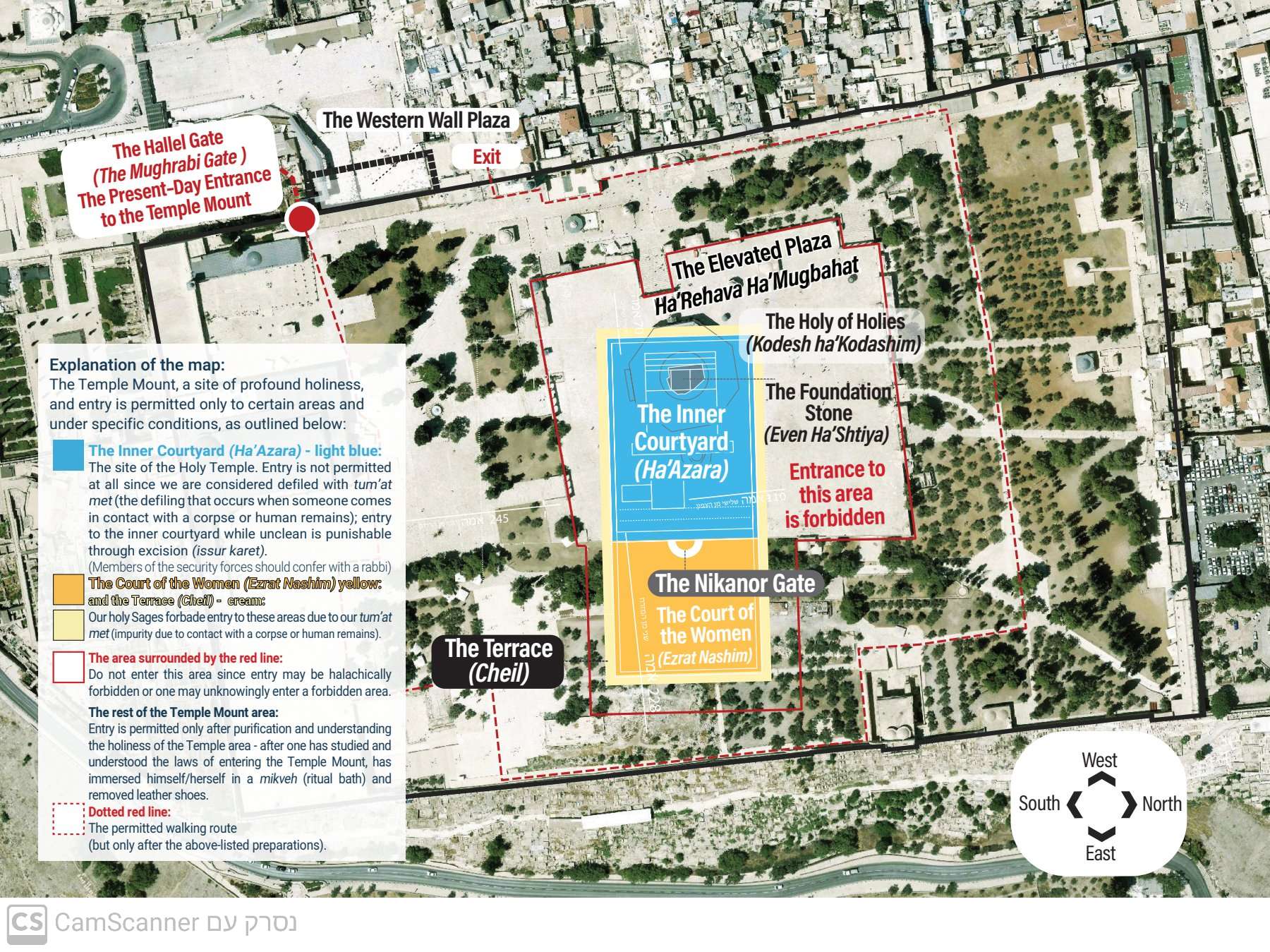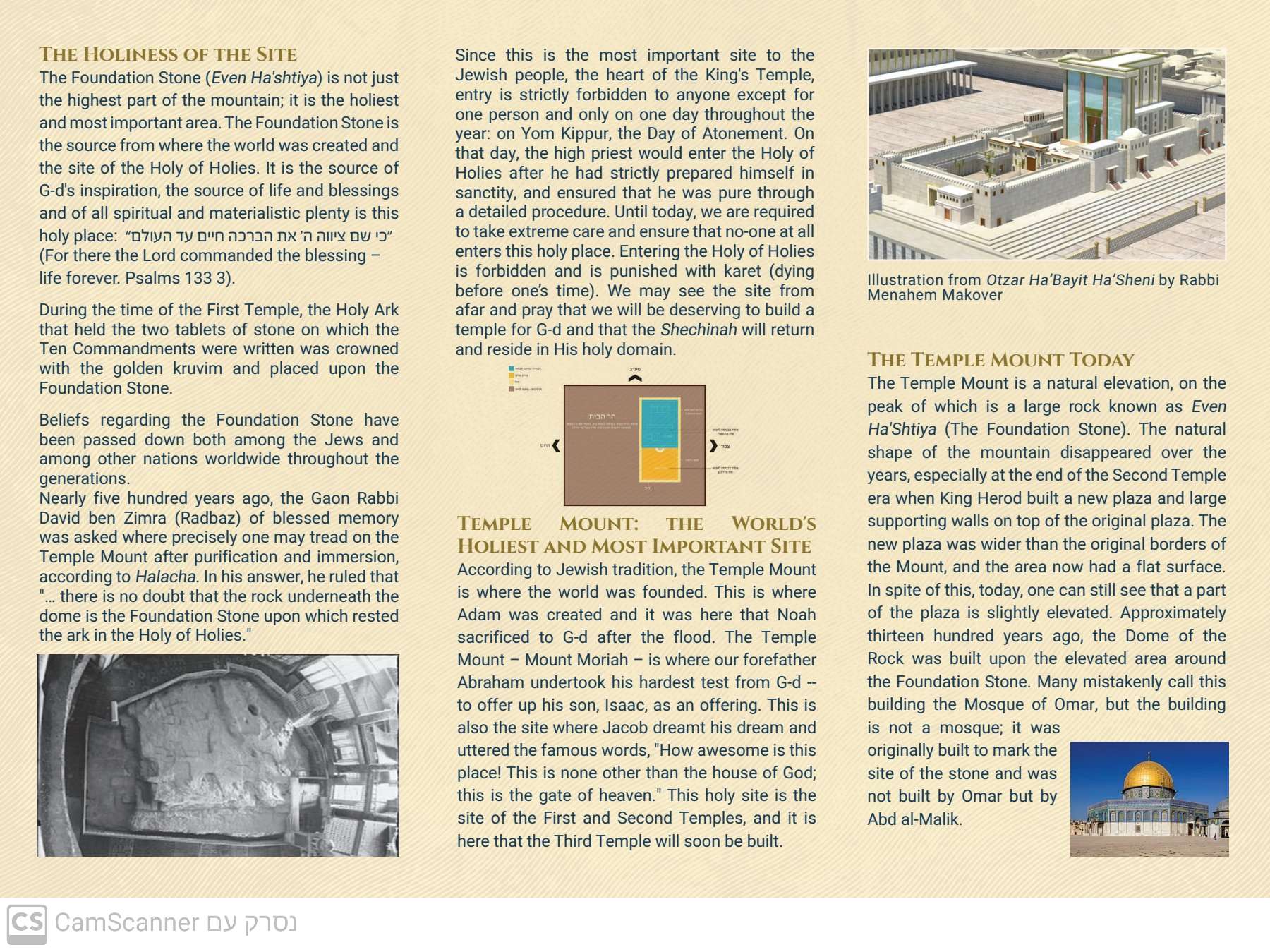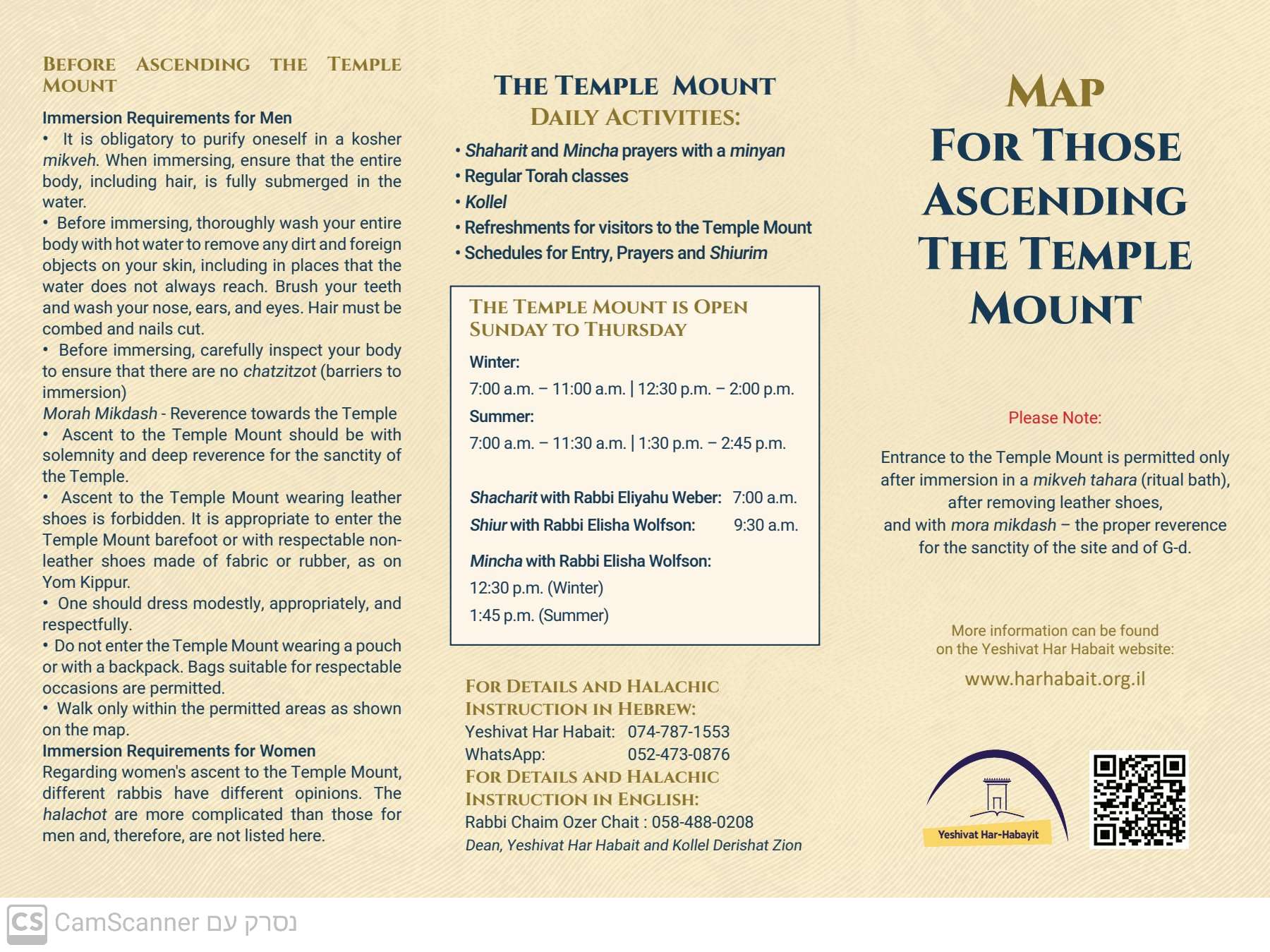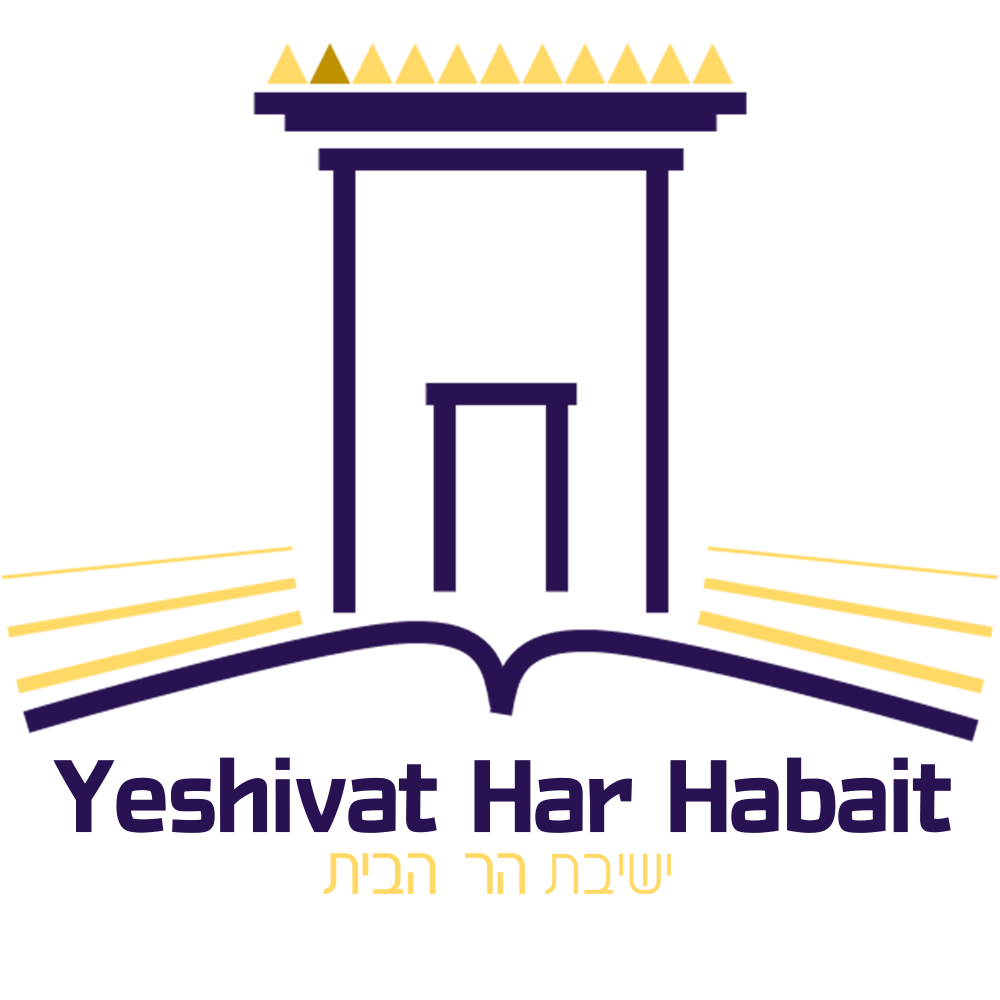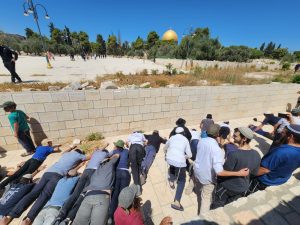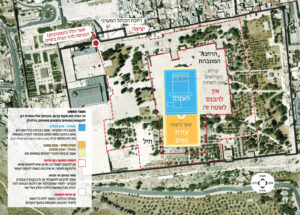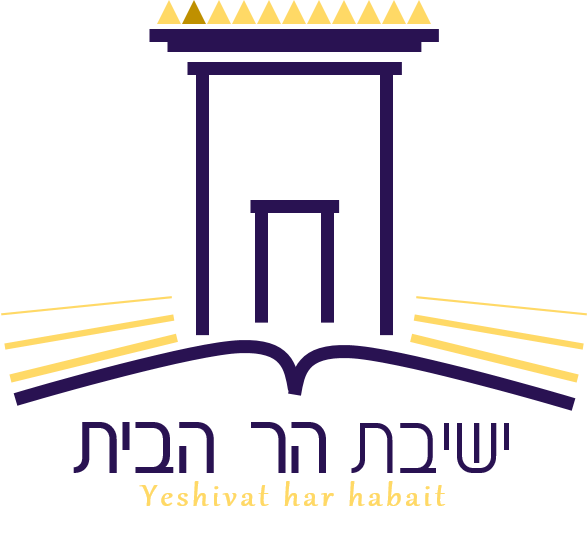Map for those Ascending the Temple Mount
Please Note:
Entrance to the Temple Mount is permitted only after immersion in a mikve tahara (ritual bath), after removing leather shoes, and with mora mikdash – the proper reverence for the sanctity of the site and of G-d.
More information can be found on the Yeshivat Har Habayit website:
www.harhbait.org.il
Daily Activities:
Shaharit and Minha prayers with a minyan
Regular Torah classes
Kolel
Refreshments for visitors to the Temple Mount
Schedules for Entry, Prayers and Classes
The Temple Mount is Open
Sunday to Thursday
Winter: 7.00 a.m. – 11.00 a.m. 12.30 p.m. – 2.00 p.m.
Summer: 7.00 a.m. – 11.30 a.m. 1.30 p.m. – 2.45 p.m.
Shaharit with Rabbi Eliyahu Weber: 7.00 a.m.
Class with Rabbi Elisha Wolfson: 9.30 a.m.
Minha with Rabbi Elisha Wolfson: 12.30 p.m. (winter)
1.45 p.m. (summ4)
For Details and Halachic Instruction in Hebrew:
Yeshivat Har Habait: 074-787-1553
WhatsApp: 052-473-0876
For Details and Halachic Instruction in English:
Rabbi Chaim Ozer Chait, Dean, 058-488-0208
Yeshivat Har Habait and Kollel Derishat Zion
Before Ascending the Temple Mount
Immersion Requirements for Men
It is obligatory to purify oneself in a kosher mikve. When immersing, ensure that the entire body, including hair, is fully submerged in the water.
Before immersing, thoroughly wash your entire body with hot water to remove any dirt and foreign bodies on your skin, including in places that the water does not always reach. Brush your teeth and wash your nose, ears, and eyes. Hair must be combed and nails cut.
Before immersing, carefully inspect your body to ensure that there are no chatzitzot (separations)
Mora Mikdash – Reverence towards the Temple
Ascent to the Temple Mount should be with solemnity and deep reverence for the sanctity of the Temple.
Ascent to the Temple Mount wearing leather shoes is forbidden. It is appropriate to enter the Mount barefoot or with respectable non-leather shoes made of fabric or rubber, as on Yom Kippur.
One should dress modestly, appropriately, and respectfully.
Do not enter the Temple Mount wearing a pouch or with a backpack. Bags suitable for respectable occasions are permitted.
Walk only within the permitted areas as shown on the map.
Immersion Requirements for Women
Regarding women’s ascent to the Temple Mount, different rabbis have different opinions. The halachot are more complicated than those for men and, therefore, are not listed here.
The Holiness of the Site
The Foundation Stone (Even Ha’shtiya) is not just the highest part of the mountain; it is the holiest and most important area. The Foundation Stone is the source from where the world was created and the site of the Holy of Holies. It is the source of G-d’s inspiration, the source of life and blessings and of all spiritual and materialistic plenty is this holy place: “כי שם ציווה ה’ את הברכה חיים עד העולם” (For there the Lord commanded the blessing – life forever. Psalms 133 3).
During the time of the First Temple, the Holy Ark that held the two tablets of stone on which the Ten Commandments were written was crowned with the golden kruvim and placed upon the Foundation Stone.
Beliefs regarding the Foundation Stone have been passed down both among the Jews and among other nations worldwide throughout the generations,.
Nearly five hundred years ago, the Gaon Rabbi David ben Zimra of blessed memory was asked where precisely one may tread on the Temple Mount after purification and immersion, according to Halacha. In his answer, he ruled that “… there is no doubt that the rock underneath the dome is the Foundation Stone upon which rested the ark in the Holy of Holies.”
Since this is the most important site to the Jewish people, the heart of the King’s Temple, entry is strictly forbidden to anyone except for one person and only on one day throughout the year: on Yom Kippur, the Day of Atonement. On that day, the high priest would enter the Holy of Holies after he had strictly prepared himself in sanctity, and ensured that he was pure through a detailed procedure. Until today, we are required to take extreme care and ensure that no-one at all enter this holy place. Entering the Holy of Holies is forbidden and is punished with karet (dying before one’s time). We may see the site from afar and pray that we will be deserving to build a temple for G-d and that the Shekinah will return and reside in His holy domain.
Temple Mount: the World’s Holiest and Most Important Site
According to Jewish tradition, the Temple Mount is where the world was founded. This is where Adam was created and it was here that Noah sacrificed to G-d after the flood. The Temple Mount – Mount Moriah – is where our forefather Abraham undertook his hardest test from G-d — to offer up his son, Isaac, as an offering. This is also the site where Jacob dreamt his dream and said uttered the famous words, “How awesome is this place! This is none other than the house of God; this is the gate of heaven.” This holy site is the site of the First and Second Temples, and it is here that the Third Temple will soon be built.
Illustration from Otzar Ha’Bayit Ha’Sheni by Rabbi Menahem Makover
The Temple Mount Today
The Temple Mount is a natural elevation, on the peak of which is a large rock known as Even Ha’Shtiya (The Foundation Stone). The natural shape of the mountain disappeared over the years, especially at the end of the Second Temple era when King Herod built a new plaza and large supporting walls on top of the original plaza. The new plaza was wider than the original borders of the Mount, and the area now had a flat surface. In spite of this, today, one can still see that a part of the plaza is slightly elevated. Approximately thirteen hundred years ago, the Dome of the Rock was built upon the elevated area around the Foundation Stone. Many mistakenly call this building the Mosque of Omar, but the building is not a mosque; it was originally built to mark the site of the stone and was not built by Omar but by Abd al-Malik.
הרחבה המוגבהת The Elevated Plaza (Ha’Rehava Ha’Mugbahat
קודש הקודשים The Holy of Holies (Kodesh ha’Kodashim)
אבן השתיה The Foundation Stone (Even Ha’Shtiya)
אין להכנס לשטח זה Entrance to this area is forbidden
העזרה The Inner Courtyard (Ha’Azara)
שער ניקנור The Nikanor Gate
עזרת נשים The Court of the Women (Ezrat Nashim)
חיל The Terrace (Cheil)
רחבת הכותל המערבי The Western Wall Plaza
שער הלל (המוגרבים) The Hallel Gate (The Mughrabi Gate)
הכניסה להר הבית בימינו Present –day Entrance to the Temple Mount
מערב West
דרום South
מזרח East
צפון North
Explanation of the map:
The Temple Mount, a site of profound holiness, and entry is permitted only to certain areas and under specific conditions, as outlined below:
The Inner Courtyard (Ha’Azara) – light blue:
The site of the Holy Temple. Entry is not permitted at all since we are considered defiled with tum’at met (the defiling that occurs when someone comes in contact with a corpse or human remains); entry to the inner courtyard while unclean is punishable through excision (issur karet).
(Members of the security forces should confer with a rabbi)
The Court of the Women (Ezrat Nashim) – yellow:
and the Terrace (Cheil) – cream:
Our holy Sages forbade entry to these areas due to our tum’at met (impurity due to contact with a corpse or human remains).
The area surrounded by the red line:
Do not enter this area since entry may be halachically forbidden or one may unknowingly enter a forbidden area.
The rest of the Temple Mount area:
Entry is permitted only after purification and understanding the holiness of the Temple area – after one has studied and understood the laws of entering the Temple Mount, has immersed himself/herself in a mikve (ritual bath) and removed leather shoes.
Dotted red line:
The permitted walking route (but only after the above-מפה פרוספקט באנגלית (4)listed preparations).
